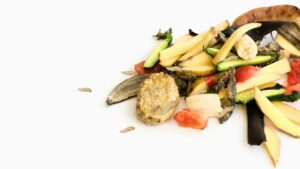BIOvative Magazin » Ocean Plastic
Ocean Plastic: Greenwashing oder Lösung gegen die Plastikflut?
Inhalte
- Wir ersticken im Plastikmüll
- Was ist Ocean Plastic und wie trägt es zur Lösung der Krise bei?
- Wie lässt sich Kunststoff wieder verwerten?
- Wie lässt sich „Ocean Plastic“ recyclen?
- Greenwashing mit „Ocean Plastic“
- Adidas x Parley
- Coca Cola’s Einwegflaschen aus Meeresplastik
- Positive Maßnahmen gegen „Ocean Plastic“
- The Ocean Cleanup
- One Earth – One Ocean
- Everwave
Ocean Plastic: Greenwashing oder Lösung gegen die Plastikflut?
- 15. Mai 2023
- Autor: Philipp Dyllong
- Lesezeit: 11 Minuten
Ein Begriff, der in den letzten Jahren viel durch die Medien ging, ist „Ocean Plastic“. Hierbei stellen Unternehmen ihre Produkte aus im Meer gesammelten Plastikabfällen her und bekämpfen dabei gleichzeitig die Plastikflut in unseren Ozeanen. So zumindest wird es uns von Adidas, Henkel und Co. vermittelt.
Wie viel an diesen Behauptungen wirklich dran ist und ob es sich hierbei auch nur wieder um Greenwashing handelt, erfährst Du in diesem Beitrag. Denn wenn die Sache wirklich so einfach wäre, warum machen es dann nicht viel mehr Unternehmen so?

Wir ersticken im Plastikmüll
Seit den 1950er Jahren ist Plastik in unserem Alltag kaum noch wegzudenken. Während damals „nur“ 1,5 Mio. Tonnen Plastik pro Jahr produziert wurden, sind es heutzutage schon fast 400 Millionen Tonnen jährlich und manche Schätzungen gehen von 1 Mrd. Tonnen jährlich im Jahr 2050 aus. Allein in Europa arbeiten 1,5 Mio. Menschen in der Kunststoffproduktion.
Ein großer Teil dieses Plastiks landet dabei in den Meeren – etwa 4,8 bis 12,7 Mio. Tonnen pro Jahr. Etwa 80% stammt aus Asien, vor allem China, die Philippinen, Indonesien, Thailand und Vietnam verursachen große Mengen an Müll. Dabei gelangt das Plastik aufgrund ungenügender Müllentsorgungssysteme über Flüsse ins Meer.
Dort bilden sich große schwimmende Müllstrudel, die jeweils mehrere Mio. Tonnen Plastik umfassen. Diese Müllstrudel stellen aber nur etwa 15% des Plastikmülls in unseren Ozeanen dar. Weitere 15% werden wieder angeschwemmt und unglaubliche 70% sinken nach und nach auf den Meeresboden.
Was ist Ocean Plastic und wie trägt es zur Lösung der Krise bei?
Wie so oft im Bereich des nachhaltigen Wirtschaftens ist der Begriff „Ocean Plastic“ nicht genau definiert und bietet somit jede Menge Interpretationsspielraum, der von den Unternehmen auch gern genutzt wird. Da oft damit geworben wird, die Ozeane sauberer zu machen, liegt jedoch die Ansicht nahe, dass „Ocean Plastic“ Kunststoffe meint, die aus dem Ozean gefischt wurden. Warum diese Unterscheidung wichtig ist, erfährst Du später im Beitrag.
Grundsätzlich handelt es sich beim Konzept von „Ocean Plastic“ also um eine Recycling-Methode. Daher verschaffen wir uns mal einen kurzen Überblick über die Recycling-Fähigkeit von Plastik.
Wie lässt sich der Kunststoff wieder verwerten?
Wie du sicher weißt, bestehen traditionelle Kunststoffe zu großen Teilen aus dem fossilen Energieträger Erdöl. Mittels verschiedener industrieller Prozesse werden daraus Kunststoffe hergestellt, zum Beispiel Polypropylen (PP), Polyethylenterephthalat (PET) oder Polyamid (PA), die für verschiedene Einsatzzwecke genutzt werden.
Um dieses Plastik wieder nutzbar zu machen, gibt es verschiedene Methoden. Bei der thermischen Verwertung wird das Plastik einfach nur verbrannt und es besteht die Gefahr von Giftstoffbildung und CO2 wird freigesetzt. Recycling ist das natürlich nicht. Beim rohstofflichen Recycling wird unter hohen Temperaturen und mit entsprechendem Energiebedarf eine Aufspaltung des Kunststoffs erreicht.
Beim werkstofflichen Recycling hingegen wird der Kunststoff sortiert, aufbereitet und zu Granulat gemahlen, aus dem wiederum neue Produkte entstehen können. Diese Methode ist dadurch am umweltschonendsten und allgemein recht effizient.
Wie lässt sich „Ocean Plastic“ recyclen?
Um neue Produkte aus „Ocean Plastic“ zu erstellen, müssen die Abfälle also werkstofflich recycelt werden. Das bedeutet, dass der Müll gesammelt, sortiert, gereinigt und weiterverarbeitet werden muss. Oftmals ist Müll aus den Ozeanen aber sehr stark verschmutzt und vermischt und muss im ersten Schritt aufwändig von Sand, Kalk und sonstigen Ablagerungen befreit werden, bevor überhaupt an eine Sortierung und Weiterverarbeitung zu denken ist.
Aussagen von Gilian Gerke – Professorin für Abfallwirtschaft der Hochschule Magdeburg-Stendal – zufolge ist dieser Prozess extrem aufwändig und nur schwer in industriellem Maßstab vorstellbar. Oftmals wird daher nur ein Teil des Mülls erneut genutzt, leere Plastikflaschen zum Beispiel. Entsprechend unwahrscheinlich wirken Behauptungen großer Unternehmen, tatsächlich „Ocean Plastic“ zu nutzen. Gesammelter Müll, der nicht weiterverarbeitet werden kann, wird oftmals auch verbrannt. Daher wollen wir uns jetzt kurz einige Beispiele ansehen.
Greenwashing mit „Ocean Plastic“
Adidas x Parley
In seiner seit 2015 laufenden Zusammenarbeit mit der Umweltorganisation Parley for the Oceans bietet Adidas seit einigen Jahren unter anderem Schuhe aus „Ocean Plastic“ an. Dabei vermittelt das Unternehmen den Kunden, dass die Kunststoffe, die in den Garnen verwendet werden, aus Meeresmüll stammen.
Nachprüfen lassen sich diese Behauptungen nicht und im Licht der Expertenmeinung von Fr. Gerke von der Hochschule Magdeburg-Stendal scheint es unwahrscheinlich, dass bei einem derart aufwendigen Herstellungsprozess am Ende ein Paar Schuhe für nur 150 Euro herauskommt.
Adidas nutzt hier eine klassische Greenwashing-Technik, indem es Aussagen aufstellt, für die es dann keine Beweise nachliefert. Auf Nachfrage gibt der Konzern dann auch zu, dass das Plastik von Stränden und Küstenregionen stammt und dort recycelt wurde, bevor es in den Ozean gelangen konnte. Natürlich wurde recycelt und Müll wieder verwertet. Die Verbraucher wurden trotzdem über den Ursprung des Plastiks getäuscht, denn er stammt keineswegs aus den Ozeanen.
Coca Cola’s Einwegflaschen aus Meeresplastik
Der Konzern hat 2019 verkündet, dass seine Einwegflaschen künftig zu 25% aus Meeresplastik bestehen sollen. Das soll jedoch von der Tatsache ablenken, dass Coca Cola der weltweit größte Verursacher von Verpackungsmüll ist. Das Unternehmen allein ist jährlich für mehr als 3 Mio. Tonnen Kunststoffprodukte verantwortlich.
Das Hauptproblem ist jedoch, dass es sich bei dieser immensen Zahl fast ausschließlich um Einwegflaschen handelt, die unsere Umwelt stark belasten. In über 50 Ländern wurden Coca-Cola-Produkte als einer der Hauptverursacher von Plastikverschmutzung ausgemacht.
Die Lösung kann hier nicht sein, einen kleinen Teil des eigenen Plastikmülls über Recycling schönzufärben, sondern nur, aktiv mittels Mehrwegsystemen dagegen vorzugehen. Coca-Cola nutzt hier ganz klar einen heimlichen Kompromiss, um vom großen Ganzen abzulenken. Wenn du mehr darüber erfahren willst, haben wir hier einen Artikel zu mehr Techniken, mit denen Du mittels Greenwashing getäuscht werden sollst.
Positive Maßnahmen gegen „Ocean Plastic“
Neben den unvermeidlichen schwarzen Schafen gibt es jedoch auch einige Unternehmen und Organisationen, die sich die Bekämpfung von „Ocean Plastic“ auf die Fahnen geschrieben haben. Hier wollen wir Dir einige der vielversprechendsten kurz vorstellen:
The Ocean Cleanup
Wahrscheinlich haben sehr viele im Zusammenhang mit Ocean Plastic bereits von „The Ocean Cleanup“ (kurz: TOC) gehört. Gegründet wurde das Projekt vom Niederländer Boyan Slat. TOC hat lange Schleppnetze entwickelt, mit denen es langsam die am stärksten verschmutzten Bereiche des Ozeans abfährt und so den an der Oberfläche treibenden Müll einsammelt. Durch die langsame Geschwindigkeit kommt es nicht zu Beifang, das heißt, es verfangen sich keine Lebewesen in den Netzen. Mittlerweile tüftelt TOC an der dritten und größten Version ihres Systems, um skalierbar und effizienter zu werden.
One Earth – One Ocean
Eine ähnliche Herangehensweise verfolgt die Organisation „One Earth – One Ocean“ (kurz: OE-OO). Anstatt sich hauptsächlich auf die offenen Meere zu konzentrieren, hat sich OE-OO auf Küstengebiete, Flussmündungen und Binnengewässer ausgerichtet. Zwei verschiedene Katamarane sammeln auch bei „One Earth – One Ocean“ Müll, der auf der Wasseroberfläche treibt. Gleichzeitig wird direkt vor Ort Feldforschung in Bezug auf die gefundenen Kunststoffe betrieben.
Außerdem tüfftelt die Organisation derzeit an einem Schiff, mit welchem der gesammelte Müll direkt vor Ort recycelt werden soll.
Everwave
Auch Everwave hat sich auf die Fahnen geschrieben, die Müllflut in unseren Gewässern zu bekämpfen. Ursprünglich wurde hierfür eine innovative Anlage entwickelt, die sich die Strömungskräfte im Meer zu Nutze macht und dadurch nicht nur Plastikmüll von der Oberfläche, sondern auch aus tieferen Schichten fördert und sammelt. Da 70% des Plastikmülls nach unten sinken, ist das eine wirklich gute Idee.
Leider werden diese Plattformen aktuell nur in Flüssen eingesetzt, da sie zu anfällig für das offene Meer sind. Trotzdem sammeln sie dort natürlich eine Unmenge an Müll, der sonst in die Meere transportiert werden würde. Außerdem nutzt Everwave ebenfalls Müllsammelboote, ähnlich wie OE – OO.
Bleibe skeptisch
Wie so oft nutzen Unternehmen auch die Thematik Plastikmüll bzw. Ozeanverschmutzung für Marketingzwecke. Oft kommt es dabei zum Greenwashing, mal versehentlich, doch oft absichtlich. Daher solltest Du wie auch bei anderen Behauptungen rund um das Thema Nachhaltigkeit und Umweltaspekte sehr vorsichtig mit diesen Aussagen umgehen. Wie Du Greenwashing-Versuche erkennen kannst, erfährst Du hier.
Neben jeder Menge schwarzer Schafe gibt es dabei aber auch ein paar Lichtblicke, wie wir Dir hoffentlich zeigen konnten. Grundsätzlich gilt: Bleibe stets skeptisch und hinterfrage die Dinge.
Du möchtest auf dem Laufenden bleiben? Melde Dich für unseren Newsletter an und folge uns auf Social Media, um automatisch News zum Klimaschutzgesetz und anderen spannenden Nachhaltigkeits-Themen von uns zu erhalten!

Philipp Dyllong

Philipp Dyllong
Diese Artikel könnten Dich auch interessieren

Neues Biomüll-Gesetz 2025: Was sich für Dich ändert
Ab dem 1. Mai 2025 tritt in Deutschland eine neue Verordnung in Kraft, die die Entsorgung von Biomüll strenger regelt. Ziel ist es, die Qualität des Biomülls zu verbessern und die Umweltbelastung durch Fremdstoffe zu reduzieren. Doch was bedeutet das konkret für Dich als Verbraucher:in?

Maden in der Biotonne: Was tun?
Die Biotonne ist praktisch, umweltschonend – und im Sommer willkommenes Zuhause für allerlei Ungeziefer. Deshalb haben wir wertvolle Tipps zusammengestellt, die zeigen, was Du gegen Maden in der Biotonne tun kannst.

Zeitungspapier
Grundsätzlich ist Zeitungspapier biologisch abbaubar und kann daher auch in geringen Mengen in die Biotonne geworfen werden.

